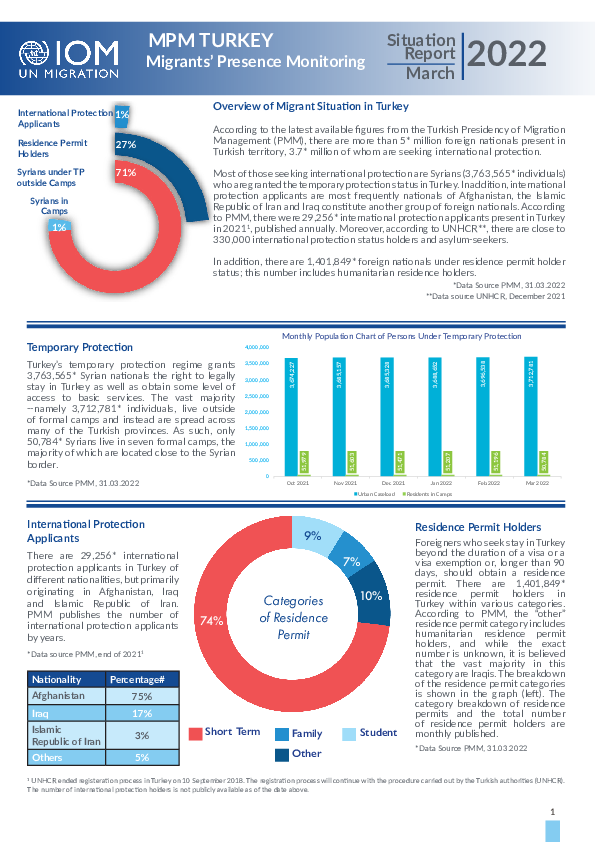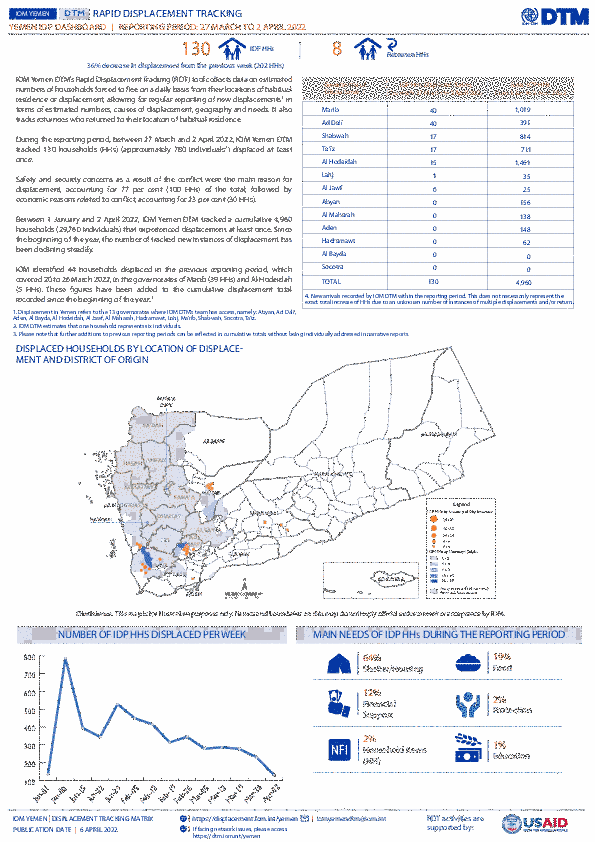-
Countries
-
Data and Analysis
-
Special Focus
-
Crisis Responses

Contact
DTM Turkey, DTMTurkey@iom.int
Language
English
Location
Republic of Türkiye
Period Covered
Mar 01 2022
Mar 31 2022
Activity
- Flow Monitoring Survey
- Flow Monitoring
According to the latest available figures from the Turkish Presidency of Migration Management (PMM), there are more than 5* million foreign nationals present in Turkish territory, 3.7* million of whom are seeking international protection. Most are Syrians (3,763,565* individuals) who are granted temporary protection status. In addition, international protection applicants from countries including Afghanistan, the Islamic Republic of Iran and Iraq constitute another group of foreign nationals. According to
PMM, there were 29,256* international protection applicants present in Turkey in 20211, published annually. Moreover, according to UNHCR**, there are close to 330,000 international protection status holders and asylum-seekers. The number of foreign nationals has increased by 95,541 in comparison to March 2021 (3.6 million foreign nationals).
In addition, there are 1,401,849* foreign nationals present in Turkey holding residency permits, including humanitarian residency holders. Compared to March 2021, this is an increase of 356,504 individuals. The exact number of humanitarian residency holders is unknown, but it is estimated that there are more than several thousand humanitarian residency permit holders.
*Data source PMM, 31.03.2022
**Data source UNHCR, December 2021

Contact
DTM Turkey, dtmturkey@iom.int
Language
English
Location
Republic of Türkiye
Period Covered
Mar 01 2022
Mar 31 2022
Activity
- Flow Monitoring Survey
- Flow Monitoring
- Migrants presence
According to the latest available figures from the Turkish Presidency of Migration Management (PMM), there are more than 5* million foreign nationals present in Turkish territory, 3.7* million of whom are seeking international protection.
Most of those seeking international protection are Syrians (3,763,565* individuals) who are granted the temporary protection status in Turkey. In addition, international protection applicants are most frequently nationals of Afghanistan, the Islamic Republic of Iran and Iraq constitute another group of foreign nationals. According to PMM, there were 29,256* international protection applicants present in Turkey in 20211, published annually. Moreover, according to UNHCR**, there are close to 330,000 international protection status holders and asylum-seekers.
In addition, there are 1,401,849* foreign nationals under residence permit holder status; this number includes humanitarian residence holders.
*Data Source PMM, 31.03.2022
**Data source UNHCR, December 2021

Contact
DTM Nigeria, AllUsersInDTMNigeria@iom.int
Language
English
Location
Nigeria
Period Covered
Mar 28 2022
Apr 03 2022
Activity
- Event Tracking
- Mobility Tracking
The DTM Emergency Tracking Tool (ETT) is deployed to track and to collect information on large and sudden population movements, provide frequent updates on the scale of displacement and quantify the affected population when needed. As a sub-component of the Mobility Tracking methodology in Nigeria. ETT utilises direct observation and a broad network of key informants to capture best estimates of the affected population per location, enabling targeted humanitarian response planning.
Between 28 March and 03 April 2022, a total of 2,440 movements were recorded in Adamawa and Borno States. The recorded movements consisted of 2,084 arrivals and 356 departures. Arrivals were recorded at locations in Askira/Uba, Bama, Gwoza, Kala/Balge and Ngala Local Government Areas (LGAs) of the most conflict-affected state of Borno and in Fufore, Gombi, Hong, Lamurde, Maiha, Michika, Mubi North, Mubi South, Song, Yola North and Yola South LGAs of Adamawa State.
Departures were recorded in Askira/Uba and Bama LGAs of Borno State and in Fufore, Gombi, Hong, Maiha, Michika, Mubi North, Numan, Song, Yola North and Yola South LGAs of Adamawa State. ETT assessments identified the following movement triggers: voluntary relocation (1,175 individuals or 48%), military operations (491 individuals or 20%), poor living conditions (399 individuals or 16%), improved security (262 individuals or 11%), fear of attacks (53 individuals or 2%), conflicts/attacks (43 individuals or 2%) and seasonal farming (17 individuals or 1%).
The Horn of Africa and Yemen is one of the busiest and riskiest migration corridors in the world travelled by hundreds of thousands of migrants, the majority of whom travel in an irregular manner, often relying on smugglers to facilitate movement along the Eastern Route. This regional report provides monthly updates on the complex migratory dynamics through Djibouti, Somalia, Yemen and Ethiopia based on diverse data sources and consultations with key informants in the four countries. Moreover, it provides information on the main protection concerns for migrants along the journey, information on the spill over effects of the conflict in Northern Ethiopia observed at the border between Ethiopia, Kenya and Sudan, a specific focus on children and information on the returns from Saudi Arabia to Ethiopia, Somalia and Yemen.

Contact
dtmcovid19@iom.int
Language
English
Location
Global
Period Covered
Mar 13 2020
Mar 31 2022
Activity
- Mobility Tracking
- Points of Entry (PoE)
IOM COVID-19 Impact on Points of Entry Monthly Analysis is meant to serve IOM Member States, IOM, UN and voluntary partner agencies, the civil society (including media) as well as the general population in analysing the impact of COVID-19 pandemic on Points of Entry. It is particularly relevant when identifying and addressing specific needs faced by migrants and mobile populations, disproportionately affected by global mobility restrictions. The report is based on information provided by IOM field staff, using resources available at the IOM country office level and is accurate to the best of IOM’s knowledge at the time of compilation. All information is being constantly validated, including the geolocation and attributes, and through regular assessments and triangulation of information. The updates depend on the time frame within which the information becomes available and is processed by IOM. For this reason, the analysis is always dated and timestamped in order to reflect reality at a given time. However, as the situation continuously evolves and changes, despite IOM’s best efforts, the analysis may not always accurately reflect the multiple and simultaneous restrictive measures being imposed at a specific location.
The current outbreak of COVID-19 has affected global mobility in complex and unprecedented ways in the form of various travel restrictions, suspension of air travel, and border closures. To better understand this, the International Organization for Migration (IOM) has developed a global mobility database to map these impacts on human mobility, across global, regional, and country levels. Furthermore, COVID-19 has had a disproportionate impact on vulnerable populations in camps and camp-like settings as well as exacerbated the vulnerabilities of mobile populations who may now be stranded owing to COVID-19 related mobility restrictions. This data is particularly important when addressing specific needs faced by migrants and mobile populations.
IOM has developed a global mobility database mapping the status of different Points of Entry (PoE) and Key Locations of Internal Mobility, globally. These include airports, land border crossing points (could be rail or road), blue border crossing points (sea, river or lake), internal transit points, and areas of interest. For each point of entry, data is collected on the type of restriction, measured applied, and the timeframe, as well as the population category that may be affected by the restrictive measures. This workstream uses direct input from IOM missions and this dashboard displays regularly updated mobility restrictions at the location level.

Contact
DTM Yemen, iomyemendtm@iom.int
Language
English
Location
Yemen
Period Covered
Mar 27 2022
Apr 02 2022
Activity
- Rapid Emergency Registration
- Mobility Tracking
IOM Yemen DTM’s Rapid Displacement Tracking (RDT) tool collects data on estimated numbers of households forced to flee on a daily basis from their locations of origin or displacement, allowing for regular reporting of new displacements in terms of estimated numbers, geography, and needs. It also tracks returnees who returned to their location of origin.
From 1 January 2022 to 2 April 2022, IOM Yemen DTM tracked 4,960 households (HH) (29,760 Individuals) who experienced displacement at least once.
Between 27 March and 02 April 2022, IOM Yemen DTM tracked 130 households (780 individuals) displaced at least once. The majority of people moved into/within the following governorates and districts:
- Ad Dali (40 HHs) – Ad Dali (18 HHs), Qatabah (15 HHs), Al Hasayn (6 HHs) districts. Most displacements in the governorate originated from Ad Dali and Ibb.
- Marib (40 HHs) – Marib City (30 HHs), Marib (10 HHs) districts. Most displacements in the governorate originated from Marib and Taiz.
- Taiz (17 HHs) – Mawza (14 HHs), Al Qahirah (3 HHs) districts. Most displacements in the governorate originated from Taiz and Al Hodeidah.
The majority of people moved from the following governorates and districts
- Taiz (29 HHs) – Maqbanah (12 HHs), Mawza (6 HHs), Sabir Al Mawadim (4 HHs) districts.
- Al Hodeidah (18 HHs) – Hays (6 HHs), Zabid (3 HHs), Al Jarrahi (2 HHs) districts.
- Ad Dali (18 HHs) – Qatabah (14 HHs), Al Husha (4 HHs) districts.
Contact
DTM Yemen, iomyemendtm@iom.int
Location
Yemen
Activity
- Event Tracking
- Mobility Tracking
Period Covered
Mar 27 2022 -Apr 02 2022
Between 27 March and 02 April 2022, IOM Yemen DTM tracked 130 households (780 individuals) displaced at least once. The majority of people moved into/within the following governorates and districts:
• Ad Dali (40 HHs) – Ad Dali (18 HHs), Qatabah (15 HHs), Al Hasayn (6 HHs) districts. Most displacements in the governorate originated from Ad Dali and Ibb.
• Marib (40 HHs) – Marib City (30 HHs), Marib (10 HHs) districts. Most displacements in the governorate originated from Marib and Taiz.
• Taiz (17 HHs) – Mawza (14 HHs), Al Qahirah (3 HHs) districts. Most displacements in the governorate originated from Taiz and Al Hodeidah.
The majority of people moved from the following governorates and districts
• Taiz (29 HHs) – Maqbanah (12 HHs), Mawza (6 HHs), Sabir Al Mawadim (4 HHs) districts.
• Al Hodeidah (18 HHs) – Hays (6 HHs), Zabid (3 HHs), Al Jarrahi (2 HHs) districts.
• Ad Dali (18 HHs) – Qatabah (14 HHs), Al Husha (4 HHs) districts.
Population Groups
Survey Methodology
Unit of Analysis Or Observation
Type of Survey or Assessment
Keywords
Geographical Scope
Administrative boundaries with available data
The current dataset covers the following administrative boundaries

Contact
DTM Nigeria, AllUsersInDTMNigeria@iom.int
Language
English
Location
Nigeria
Period Covered
Nov 16 2021
Dec 30 2021
Activity
- Mobility Tracking
- Baseline Assessment
This factsheet presents key findings from the period 16 November to 30 December 2021, this represents the results from the Round 9 of Displacement Tracking Matrix (DTM) assessments carried out by the International Organization for Migration (IOM) in North-central & North-west Zone.
During Round 9, DTM identified 969,757 IDPs (157,519 households).

Contact
DTM South Sudan, SouthSudanDTM@iom.int
Language
English
Location
South Sudan
Period Covered
Jan 01 2022
Jan 31 2022
Activity
- Flow Monitoring
DTM’s Flow Monitoring Registry (FMR) surveys people on the move at key transit points within South Sudan (SSD) and at its borders. It provides an insight into mobility trends, migration drivers and traveller profiles to inform programming by humanitarian and development partners and by the government, complementing DTM’s monitoring of COVID-19 mobility restrictions. In total, 27 Flow Monitoring Points (FMPs) were active in January 2022, surveying internal flows and cross-border travel with Uganda (UGA), the Democratic Republic of Congo (DRC), Sudan (SDN), Ethiopia (ETH), Kenya (KEN) and the Central African Republic (CAR). In January, the FMP in Raja Town was reopened. Activities at Rubkona Suksita were temporarily moved to Bentiu IDP Camp (Canoe Station) due to flooding. The FMP Malakal Bus Station continues to be suspended. Figures are only indicative of existing trends among respondents at the active FMPs since DTM does not have full coverage of cross-border or internal flows. Participation in the survey is voluntary and anonymous.
Please click here to access a summary dataset.

